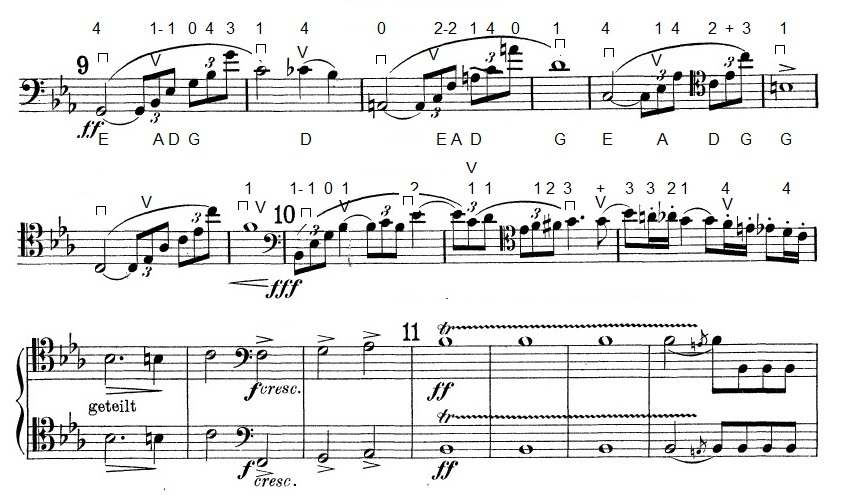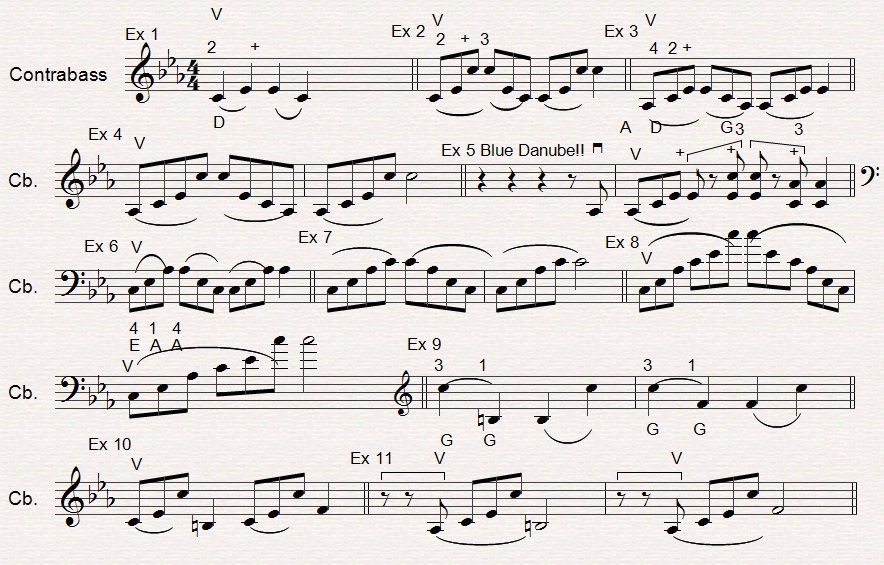ein heldenleben fig 9
There is little doubt that this excerpt is at the top of most bass players
practice list before and audition. It is one of the most popular choices for a
bass audition list and in my view it is the hardest in the repertoire, along
with the last movement of Mozart 40.
YouTubeClip

Fig 1 - my version of the infamous Fig 9 passage
I have found very few versions in the literature, which is a surprise
considering how this comes up in auditions and how difficult it is. There is an
old printed book of Richard Strauss orchestral excerpts, which has a few
fingerings but no strings marked, and there are many ways to play these
passages, on a number of strings.
There are a number of issues the player needs to consider before deciding on how
to play this passage:-
1 string crossing vs shifts. the age old dilemma is present in
just about every bar, for example some players play the B natural (3 before 10)
and the F (bar before 10) across on either the D or even the A strings, I shift
back on the G.
2 Left hand - this is a fiendish passage that requires extreme
LH techniques, covered in the exercises below
3 Right hand - the bass player who focusses on the left hand
and ignores the right is in peril in the passage (if not all passages!). The
arpeggios cover a two octave range, from the bottom string to the top and the
bowings normally used required uneven distribution, eg two bows in bar 3, one in
bar 4. Successful combinations of weight, speed and position on the string are
crucial, as well as smooth string crossings and bow changes.
How to prepare (long term) -
I believe that this passage, and the last movement of Mozart 40 are the hardest
in the repertoire, and cannot be brought up to speed a week before an audition.
The prep is much longer, for me at least. The first issue for me is to develop a
thumb calous for the E flats on the D string. He help do this, and to overcome
other technical issues, I do the following exercises:-

Fig 2 - exercises
Ex 1 is good for helping develop a calous, as well as fixing the shift to the E
flat and switch from neck to thumb position. When the thumb gets stronger I do
scales up the D string, with thumb alone, to build it up further. The strength
of the thumb required to do this fingering is one reason why this passage cannot
be learnt in a short timeframe. The other exercises break up the difficult
arpeggios, 4 and 2 before 10, which I consider to be the hardest technical
passages. And Ex 5 is a bit of fun!
When doing these exercises, dont forget about the Right hand - the start of
the upward, up bow arpeggios should have more weight, less speed (lower string
has more mass), and the end should be the opposite, more speed less weight (need
to build towards to the top of the arpeggio, so need more bow). This should be
practiced using the exercises above.
Semi breves - I do not split 5 and 3 before fig 10, but I do split 1 before
10 to help make the cresc to fff. A balance needs to be struck between
demonstating a big sound with not overplaying, so I start at Fig 9 under ff, to
give me somewhere to go at 10 without overplaying. Bow speed - the bow is moving
quickly at the end of the arpeggios 6 before 10, and it needs to be slowed for
the semi breve 5 before 10, as the breve is more than twice the length of the
arpeggio up bow. Bow position on string - I allow the bow to move towards the
bridge on the arpeggios, eg 6 before 10, then keep it there for the semi breve 5
before 10, to maintain the sound with a slower bow.
Long term prep:-
do the exercises above, dont move to next one until the first is mastered.
Start slowly, go easy on the thumb calous, as it may take some time to build up
run each two bar phrase at crochet = 84, go thro each one until mastered,
increase tempo marking til eventually reach performance tempo of crochet = 100
Short term prep - in the audition warm up room:-
play each two bar phrase under tempo - fix any problems slowly (eg shift
from C to E flat 2 and 4 before fig 10)
increase tempo of each two bar phrase
whole passage at tempo
Notes written on the part - I put reminders to myself to read
in the audition just before I play:-
Bow speed - wt at start arpeggio, speed at end
space out triplets, dont rush
count thro white notes, dont drag
Relax and breathe
Extension - E flat (if playing onto the 5th of fig 11, or else E nat)
Tempo - crochet = 100 is slightly under tempo, but that is what
I play